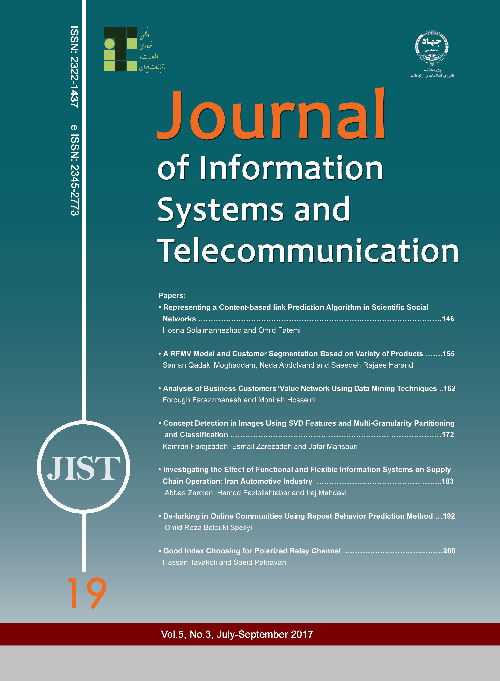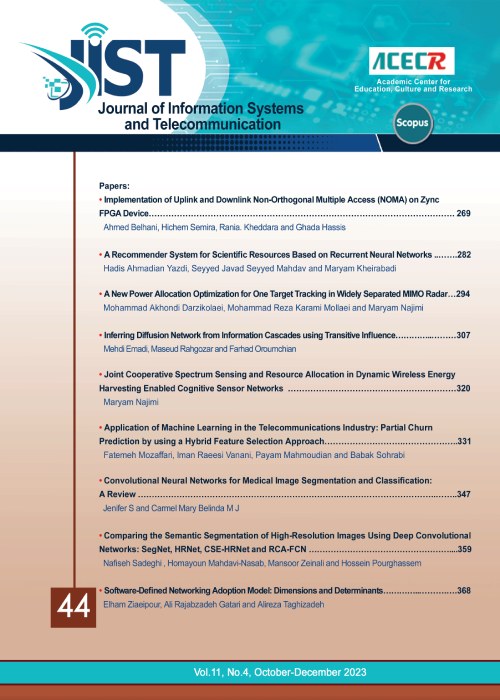فهرست مطالب

Journal of Information Systems and Telecommunication
Volume:5 Issue: 3, Jul-Sep 2017
- تاریخ انتشار: 1396/08/27
- تعداد عناوین: 7
-
-
Page 146Predicting collaboration between two authors, using their research interests, is one of the important issues that could improve the group researches. One type of social networks is the co-authorship network that is one of the most widely used data sets for studying. As a part of recent improvements of research, far much attention is devoted to the computational analysis of these social networks. The dynamics of these networks makes them challenging to study. Link prediction is one of the main problems in social networks analysis. If we represent a social network with a graph, link prediction means predicting edges that will be created between nodes in the future. The output of link prediction algorithms is using in the various areas such as recommender systems. Also, collaboration prediction between two authors using their research interests is one of the issues that improve group researches. There are few studies on link prediction that use content published by nodes for predicting collaboration between them. In this study, a new link prediction algorithm is developed based on the people interests. By extracting fields that authors have worked on them via analyzing papers published by them, this algorithm predicts their communication in future. The results of tests on SID dataset as co-author dataset show that developed algorithm outperforms all the structure-based link prediction algorithms. Finally, the reasons of algorithms efficiency are analyzed and presented.Keywords: Link prediction, Social networks, Content-based, Interest
-
Page 155Today, increased competition between organizations has led them to seek a better understanding of customer behavior through innovative ways of storing and analyzing their information. Moreover, the emergence of new computing technologies has brought about major changes in the ability of organizations to collect, store and analyze macro-data. Therefore, over thousands of data can be stored for each customer. Hence, customer satisfaction is one of the most important organizational goals. Since all customers do not represent the same profitability to an organization, understanding and identifying the valuable customers has become the most important organizational challenge. Thus, understanding customers behavioral variables and categorizing customers based on these characteristics could provide better insight that will help business owners and industries to adopt appropriate marketing strategies such as up-selling and cross-selling. The use of these strategies is based on a fundamental variable, variety of products. Diversity in individual consumption may lead to increased demand for variety of products; therefore, variety of products can be used, along with other behavioral variables, to better understand and categorize customers behavior. Given the importance of the variety of products as one of the main parameters of assessing customer behavior, studying this factor in the field of business-to-business (B2B) communication represents a vital new approach. Hence, this study aims to cluster customers based on a developed RFM model, namely RFMV, by adding a variable of variety of products (V). Therefore, CRISP-DM and K-means algorithm was used for clustering. The results of the study indicated that the variable V, variety of products, is effective in calculating customers value. Moreover, the results indicated the better customers clustering and valuation by using the RFMV model. As a whole, the results of modeling indicate that the variety of products along with other behavioral variables provide more accurate clustering than RFM model.Keywords: Clustering, Data Mining, Customer Relationship Management, Product Variety, RFM Model
-
Page 162In today's competitive environment, customers are the most important asset to any company. Therefore companies should understand what the retention and value drivers are for each customer. An approach that can help consider customers different value dimensions is the value network. This paper aims to introduce a new approach using data mining techniques for mapping and analyzing customers value network. Besides, this approach is applied in a real case study. This research contributes to develop and implement a methodology to identify and define network entities of a value network in the context of B2B relationships. To conduct this work, we use a combination of methods and techniques designed to analyze customer data-sets (e.g. RFM and customer migration) and to analyze value network. As a result, this paper develops a new strategic network view of customers and discusses how a company can add value to its customers. The proposed approach provides an opportunity for marketing managers to gain a deep understanding of their business customers, the characteristics and structure of their customers value network. This paper is the first contribution of its kind to focus exclusively on large data-set analytics to analyze value network. This new approach indicates that future research of value network can further gain the data mining tools. In this case study, we identify the value entities of the network and its value flows in the telecommunication organization using the available data in order to show that it can improve the value in the network by continuous monitoring.Keywords: Business-to-business Marketing, Business Customers Value Network, Market Segmentation, Data Mining, Telecommunication Industry, Value Network Analysis
-
Concept Detection in Images Using SVD Features and Multi-Granularity Partitioning and ClassificationPage 172New visual and static features, namely, right singular feature vector, left singular feature vector and singular value feature vector are proposed for the semantic concept detection in images. These features are derived by applying singular value decomposition (SVD) "directly" to the "raw" images. In SVD features edge, color and texture information is integrated simultaneously and is sorted based on their importance for the concept detection. Feature extraction is performed in a multi-granularity partitioning manner. In contrast to the existing systems, classification is carried out for each grid partition of each granularity separately. This separates the effect of classifications on partitions with and without the target concept on each other. Since SVD features have high dimensionality, classification is carried out with K-nearest neighbor (K-NN) algorithm that utilizes a new and "stable" distance function, namely, multiplicative distance. Experimental results on PASCAL VOC and TRECVID datasets show the effectiveness of the proposed SVD features and multi-granularity partitioning and classification method.Keywords: High, Dimensional Data, Multi, Granularity Partitioning, Classification, Multiplicative Distance, Semantic Concept Detection, Static Visual Features, SVD
-
Page 183This research studies the relationship between supply chain and information system strategies, their effects on supply chain operation and functionality of an enterprise. Our research encompasses other ones because it uses a harmonic structure between information systems and supply chain strategies in order to improve supply chain functionality. The previous research focused on effects of information systems on modification of the relationship between supply chain strategies and supply chain function. We decide to evaluate direct effects of information systems on supply chain strategies. In this research, we show that information systems strategy to improve the relationship between supply chain and supply chain strategies will be. Therefore, it can be said that creating Alignment between informational system strategy and supply chain strategies finally result in improvement of supply chain functionality and companys operation.Keywords: Functional Informational Systems, Flexible Informational Systems, Supply Chain Performance
-
Page 192Nowadays, with the advent of social networks, a big change has occurred in the structure of web-based services. Online community (OC) enable their users to access different type of Information, through the internet based structure anywhere any time. OC services are among the strategies used for production and repost of information by users interested in a specific area. In this respect, users become members in a particular domain at will and begin posting. Considering the networking structure, one of the major challenges these groups face is the lack of reposting behavior. Most users of these systems take up a lurking position toward the posts in the forum. De-lurking is a type of social media behavior where a user breaks an "online silence" or habit of passive thread viewing to engage in a virtual conversation. One of the proposed ways to improve De-Lurking is the selection and display of influential posts for each individual. Influential posts are so selected as to be more likely reposted by users based on each user's interests, knowledge and characteristics. The present article intends to introduce a new method for selecting k influential posts to ensure increased repost of information. In terms of participation in OCs, users are divided into two groups of posters and lurkers. Some solutions are proposed to encourage lurking users to participate in reposting the contents. Based on actual data from Twitter and actual blogs with respect to reposts, the assessments indicate the effectiveness of the proposed method.Keywords: De-Lurking, Post Similarity, Lurker, Online Community
-
Page 200This paper will be discussed about the relay channels polarization in order to achieve more capacity region and will be shown that if the inputs of two different relay channels followed the Arikan's polarization structure, then one can categorized these channels to good channel and bad channel. Encoding and decoding complexity for these codes are like to original polar code, O (N.log〖N)〗, and the error probability for them is O (〖2^(-(N) )〗^β ). As, a new scheme for choosing good indices for sending the information in polarized relay channel is presented. The relay channel, introduced by Van der Meulen in [1], is a communication channel and it has a sender and a receiver that assisted in communication by another way, which is a relay node. A memoryless relay channel is specified by probability distribution W(Y_r,Y|〖X,X〗_r ), where X is the transmitted symbol by the source, X_r is the transmitted symbol by the relay, Y_r is the received symbol by the relay and Y is the received symbol by the destination according to figure (1). One can assume that the message M is uniformly distributed over the message set and the average probability of error is defined as P_e^((n))=Pr{M ̂≠M}, where M is the estimation of decoder. Rate R is said to be achievable if there exist a sequence of 〖(2〗^NR,N) codes, N is the length of the code, such that 〖lim〗_(N→∞) P_e^((n))=0.Keywords: Relay channel, Polar code, Channel polarization, Capacity, Relay channel polarization, Good index of relay channel


